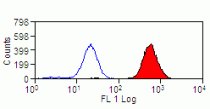ARG23071
anti-CD42a antibody [FMC-25] (FITC)
anti-CD42a antibody [FMC-25] (FITC) for Flow cytometry and Human
Overview
| Product Description | FITC-conjugated Mouse Monoclonal antibody [FMC-25] recognizes CD42a Mouse anti Human CD42a antibody, clone FMC-25 recognizes human CD42a, also known as Platelet glycoprotein IX, Glycoprotein 9 or GP-IX. CD42a is a 177 amino acid, ~20kDa type I single pass transmembrane glycoprotein containing a single leucine-rich repeat containing N-terminal domain and a single leucine-rich repeat containing C-terminal domain.CD42a is expressed by platelets and megakaryocytes and forms a covalent complex with CD42c (GP-1b-beta), CD42b (GP-1b-alpha) and CD42d (platelet glycoprotein V) to create the platelet surface receptor for von Willebrand factor. Incubation of the intact von Willebrand receptor complex with clone FMC-25 does not appear to inhibit binding of von Willebrand factor to the receptor (Yan et al. 2011). Defects in the GP1BB gene encoding human CD42a can lead to the inherited bleeding disorder Bernard-Soulier syndrome (Diz-Küçükkaya 2013), characterized by prolonged bleeding times, thrombocytopenia and the appearence of giant platelets in the circulation (Johns et al. 2014).Mouse anti human CD42a antibody, clone FMC-25 has been successfully used as a capture reagent for platelet-autoantibody complexes in the sera of patients presenting thrombocytopenia associated with anti-phospholipid syndrome (Godeau et al. 1997). |
|---|---|
| Tested Reactivity | Hu |
| Tested Application | FACS |
| Host | Mouse |
| Clonality | Monoclonal |
| Clone | FMC-25 |
| Isotype | IgG1 |
| Target Name | CD42a |
| Antigen Species | Human |
| Immunogen | Peripheral blood mononuclear cells. |
| Conjugation | FITC |
| Alternate Names | Glycoprotein 9; CD antigen CD42a; CD42a; GPIX; GP-IX; Platelet glycoprotein IX |
Application Instructions
| Application Suggestion |
|
||||
|---|---|---|---|---|---|
| Application Note | FACS: Use 10 µl of the suggested working dilution to label 10^6 cells in 100 µl. * The dilutions indicate recommended starting dilutions and the optimal dilutions or concentrations should be determined by the scientist. |
Properties
| Form | Liquid |
|---|---|
| Purification | Purification with Protein G. |
| Buffer | PBS, 0.09% Sodium azide and 1% BSA |
| Preservative | 0.09% Sodium azide |
| Stabilizer | 1% BSA |
| Concentration | 0.1 mg/ml |
| Storage Instruction | Aliquot and store in the dark at 2-8°C. Keep protected from prolonged exposure to light. Avoid repeated freeze/thaw cycles. Suggest spin the vial prior to opening. The antibody solution should be gently mixed before use. |
| Note | For laboratory research only, not for drug, diagnostic or other use. |
Bioinformation
| Database Links | |
|---|---|
| Gene Symbol | GP9 |
| Gene Full Name | glycoprotein IX (platelet) |
| Background | This gene encodes a small membrane glycoprotein found on the surface of human platelets. It forms a 1-to-1 noncovalent complex with glycoprotein Ib, a platelet surface membrane glycoprotein complex that functions as a receptor for von Willebrand factor. The complete receptor complex includes noncovalent association of the alpha and beta subunits with the protein encoded by this gene and platelet glycoprotein V. Defects in this gene are a cause of Bernard-Soulier syndrome, also known as giant platelet disease. These patients have unusually large platelets and have a clinical bleeding tendency. [provided by RefSeq, Oct 2008] |
| Function | The GPIb-V-IX complex functions as the vWF receptor and mediates vWF-dependent platelet adhesion to blood vessels. The adhesion of platelets to injured vascular surfaces in the arterial circulation is a critical initiating event in hemostasis. GP-IX may provide for membrane insertion and orientation of GP-Ib. [UniProt] |
| Calculated MW | 19 kDa |
Images (1) Click the Picture to Zoom In






